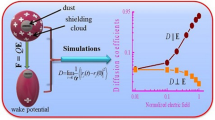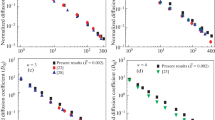Abstract
Equilibrium molecular dynamics (EMD) simulations have been executed to investigate the parallel (D║) and perpendicular (D┴) diffusion coefficients for three-dimensional (3D) strongly coupled (SC) electrorheological complex (dusty) plasmas (ERCPs). The effects of uniaxial (z-axis) AC electric field (MT) on dust grains have been investigated along with various combinations of plasma parameters (Γ, κ). The new outcomes obtained by mean squared displacement of Einstein relation show diffusion coefficients for low-intermediate to high plasma couplings (Γ) for varying MT. The D║ and D┴ at MT = 0.01 agree well with earlier available data obtained from the Green–Kubo and Einstein relation for 3D SC-Yukawa systems. The simulation data show that D║ increased with an increase in moderate MT strength and that D┴ decreased for the intermediate to large MT strength. Both (D║ and D┴) remained nearly constant for low MT values. The investigations show that the current EMD scheme is more efficient for nonideal gas-like, liquid-like, and solid-like states of SC-ERCPs. It has been demonstrated that present simulation outcomes extended the MT range up to 0.01 ≤ MT ≤ 10 to understand the diffusive and rheological behaviors of dusty plasma systems.






Similar content being viewed by others
Data availability
The data are available upon request from the authors: The data that support the findings of this study are available from the corresponding author upon reasonable request.
References
Shukla PK (2001) A survey of dusty plasma physics. Phys Plasmas 8:1791–1803. https://doi.org/10.1063/1.1343087
Shahzad A, He MG (2012) Thermal conductivity of three-dimensional Yukawa liquids (dusty plasmas). Contrib to Plasma Phys 52:667–675. https://doi.org/10.1002/ctpp.201200002
Shahzad A, He MG (2012) Thermal conductivity calculation of complex (dusty) plasmas. Phys Plasmas 19:08377. https://doi.org/10.1063/1.4748526
Shahzad A, He MG (2015) Calculations of thermal conductivity of complex (dusty) plasmas using homogenous nonequilibrium molecular simulations. Radiat Eff Defects Solids 170:758–770. https://doi.org/10.1080/10420150.2015.1108316
Shahzad A, Kashif M, Munir T et al (2020) Thermal conductivity analysis of two-dimensional complex plasma liquids and crystals. Phys Plasmas 27:103702. https://doi.org/10.1063/5.0018537
Shahzad A, Shakoori MA, He MG, Yang F (2019) Dynamical structure factor of complex plasmas for varying wave vectors. Phys Plasmas 26:023704. https://doi.org/10.1063/1.5056261
Chu JH, Lin I (1994) Direct observation of Coulomb crystals and liquids in strongly coupled rf dusty plasmas. Phys Rev Lett 72:4009–4012. https://doi.org/10.1103/PhysRevLett.72.4009
Fortov VE, Morfill GE (2009) Complex and dusty plasmas from laboratory to space. CRC Press, New York
Yichun W, Xiaoxia S, Xiaorong T, Facheng W (2010) Investigation of thermal conductivity of alumina/silicone oil electrorheological fluids. Adv Mater Res 129–131:421–425. https://doi.org/10.4028/www.scientific.net/AMR.129-131.421
Stanway R, Sproston JL, El-Wahed AK (1996) Applications of electro-rheological fluids in vibration control: a survey. Smart Mater Struct 5:464–482. https://doi.org/10.1088/0964-1726/5/4/011
Li L, Wang M, Wang J, Zhao X (2017) The control of ultrasonic transmission by the metamaterials structure of electrorheological fluid and metal foam. Smart Mater Struct 26:115006. https://doi.org/10.1088/1361-665X/aa8376
Szary ML, Noras M (2002) Experimental study of sound transmission loss in electrorheological liquids. ASME Int Mech Eng Congr Expo Proc 27:229–240. https://doi.org/10.1115/IMECE2002-33349
Kompaneets R, Morfill GE, Ivlev AV (2009) Design of new binary interaction classes in complex plasmas. Phys Plasmas 16:043705. https://doi.org/10.1063/1.3112703
Ivlev AV, Morfill GE, Thomas HM et al (2008) First observation of electrorheological plasmas. Phys Rev Lett 100:095003. https://doi.org/10.1103/PhysRevLett.100.095003
Ivlev AV, Brandt PC, Morfill GE et al (2010) Electrorheological complex plasmas. IEEE Trans Plasma Sci 38:733–740. https://doi.org/10.1109/TPS.2009.2037716
Kana D, Dietz C, Thoma MH (2020) Simulation of electrorheological plasmas with superthermal ion drift. Phys Plasmas 27:103703. https://doi.org/10.1063/5.0010021
Ivlev A, Lowen H, Morfill G, Royall CP (2011) Complex plasmas and colloidal dispersions particle-resolved studies of classical liquids and solids. Word Scientific, Singapore
Ivlev AV, Thoma MH, Räth C et al (2011) Complex plasmas in external fields: the role of non-Hamiltonian interactions. Phys Rev Lett 106:155001. https://doi.org/10.1103/PhysRevLett.106.155001
Schwabe M, Khrapak SA, Zhdanov SK et al (2020) Slowing of acoustic waves in electrorheological and string-fluid complex plasmas. New J Phys 22:083079. https://doi.org/10.1088/1367-2630/aba91b
Vaulina OS, Vladimirov SV, Petrov OF, Fortov VE (2004) Phase state and transport of non-Yukawa interacting macroparticles (complex plasma). Phys Plasmas 11:3234–3237. https://doi.org/10.1063/1.1737742
Vaulina OS, Dranzhevski IE (2006) Transport of macroparticles in dissipative two-dimensional Yukawa systems. Phys Scr 73:577–586. https://doi.org/10.1088/0031-8949/73/6/009
Ott T, Bonitz M (2011) Diffusion in a strongly coupled magnetized plasma. Phys Rev Lett 107:135003. https://doi.org/10.1103/PhysRevLett.107.135003
Dutta B, Bezbaruah P, Das N (2021) Magnetized wake driven anomalous diffusion in complex plasma. Phys Plasmas 28:083703. https://doi.org/10.1063/5.0055139
Begum M, Das N (2016) Self-diffusion as a criterion for melting of dust crystal in the presence of magnetic field. Eur Phys J Plus 131:46. https://doi.org/10.1140/epjp/i2016-16046-2
Shakoori MA, He MG, Shahzad A, Khan M (2021) Studies of self diffusion coefficient in electrorheological complex plasmas through molecular dynamics simulations. In: Shahzad A, He MG (ed) Plasma Science and Technology, Intech Open London. https://doi.org/10.5772/intechopen.98854
Shakoori MA, He M, Shahzad A, et al (2021) Molecular dynamics study of diffusion coefficient for low-temperature dusty plasmas in the presence of external electric fields. In: Shahzad A, He MG (2022) Emerging Development and Application of Low Temperature Plasma, IGI Global, Hershey, PA, 63–84. https://doi.org/10.4018/978-1-7998-8398-2.ch004
Dzhumagulova KN, Ramazanov TS, Masheeva RU (2013) Diffusion coefficient of three-dimensional Yukawa liquids. Phys Plasmas 20:113702. https://doi.org/10.1063/1.4832016
Baalrud SD, Daligault J (2015) Modified Enskog kinetic theory for strongly coupled plasmas. Phys Rev E 91:063107. https://doi.org/10.1103/PhysRevE.91.063107
Strickler TS, Langin TK, McQuillen P et al (2016) Experimental measurement of self-diffusion in a strongly coupled plasma. Phys Rev X 6:021021. https://doi.org/10.1103/PhysRevX.6.021021
Vaulina OS, Adamovich XG, Petrov OF, Fortov VE (2008) Evolution of the mass-transfer processes in nonideal dissipative systems I Numerical simulation. Phys Rev E 77:066403. https://doi.org/10.1103/physreve.77.066403
Vaulina OS, Vladimirov SV (2002) Diffusion and dynamics of macro-particles in a complex plasma. Phys Plasmas 9:835–840. https://doi.org/10.1063/1.1449888
Dzhumagulova KN, Ramazanov TS, Masheeva RU (2012) Velocity autocorrelation functions and diffusion coefficient of dusty component in complex plasmas. Contrib to Plasma Phys 52:182–185. https://doi.org/10.1002/ctpp.201100070
Shahzad A, He MG (2012) Shear viscosity and diffusion motion of two-dimensional dusty plasma liquids. Phys Scr 86:015502. https://doi.org/10.1088/0031-8949/86/01/015502
Shahzad A, He MG, He K (2013) Diffusion motion of two-dimensional weakly coupled complex (dusty) plasmas. Phys Scr 87:035501. https://doi.org/10.1088/0031-8949/87/03/035501
Ohta H, Hamaguchi S (2000) Molecular dynamics evaluation of self-diffusion in Yukawa systems. Phys Plasmas 7:4506–4514. https://doi.org/10.1063/1.1316084
Daligault J (2012) Diffusion in ionic mixtures across coupling regimes. Phys Rev Lett 108:225004. https://doi.org/10.1103/PhysRevLett.108.225004
Daligault J (2012) Practical model for the self-diffusion coefficient in Yukawa one-component plasmas. Phys Rev E 86:047401. https://doi.org/10.1103/PhysRevE.86.047401
Shahzad A, Aslam A, He MG (2014) Equilibrium molecular dynamics simulation of shear viscosity of two-dimensional complex (dusty) plasmas. Radiat Eff Defects Solids 169:931–941. https://doi.org/10.1080/10420150.2014.968852
English NJ, Waldron CJ (2015) Perspectives on external electric fields in molecular simulation: progress, prospects and challenges. Phys Chem Chem Phys 17:12407–12440. https://doi.org/10.1039/c5cp00629e
Clark R, Von Domaros M, Mcintosh AJS et al (2019) Effect of an external electric field on the dynamics and intramolecular structures of ions in an ionic liquid. J Chem Phys 151:164503. https://doi.org/10.1063/1.5129367
Tao W, Liu X, Sa X et al (2022) Tuning the molecular structure and transport property of [bmim ][Tf 2 N ] using electric field. J Therm Sci 31:1076–1083. https://doi.org/10.1007/s11630-022-1648-z
Rapaport DC (2004) The art of molecular dynamics simulation. Cambridge University Press, New York
Mazars M (2007) Yukawa potentials in systems with partial periodic boundary conditions. I. Ewald sums for quasi-two-dimensional systems. Mol Phys 105:1909–1925. https://doi.org/10.1080/00268970701481716
Acknowledgements
The authors would like to thank Dr. X. D. Zhang at the Network Information Center of Xi’an Jiaotong University for supporting the High-Performance Computing (HPC) platform and HPC Cluster of the National Centre for Physics (NCP) Islamabad for the allocation of computational power to check and run our homemade MD code.
Funding
This work was supported by the National Science Fund for Distinguished Young Scholars of China (No. 51525604) and the Foundation for Innovative Research Groups of the National Natural Science Foundation of China (No. 51721004).
Author information
Authors and Affiliations
Contributions
Muhammad Asif Shakoori wrote the main text and analyzed it. Maogang He and Aamir Shahzad supervised, reviewed, and edited, and Misbah Khan revised the manuscript.
Corresponding author
Ethics declarations
Competing interests
The authors declare no competing interests.
Additional information
Publisher's note
Springer Nature remains neutral with regard to jurisdictional claims in published maps and institutional affiliations.
Rights and permissions
Springer Nature or its licensor (e.g. a society or other partner) holds exclusive rights to this article under a publishing agreement with the author(s) or other rightsholder(s); author self-archiving of the accepted manuscript version of this article is solely governed by the terms of such publishing agreement and applicable law.
About this article
Cite this article
Shakoori, M.A., He, M., Shahzad, A. et al. Diffusion coefficients of electrorheological complex (dusty) plasmas. J Mol Model 28, 398 (2022). https://doi.org/10.1007/s00894-022-05394-3
Received:
Accepted:
Published:
DOI: https://doi.org/10.1007/s00894-022-05394-3




